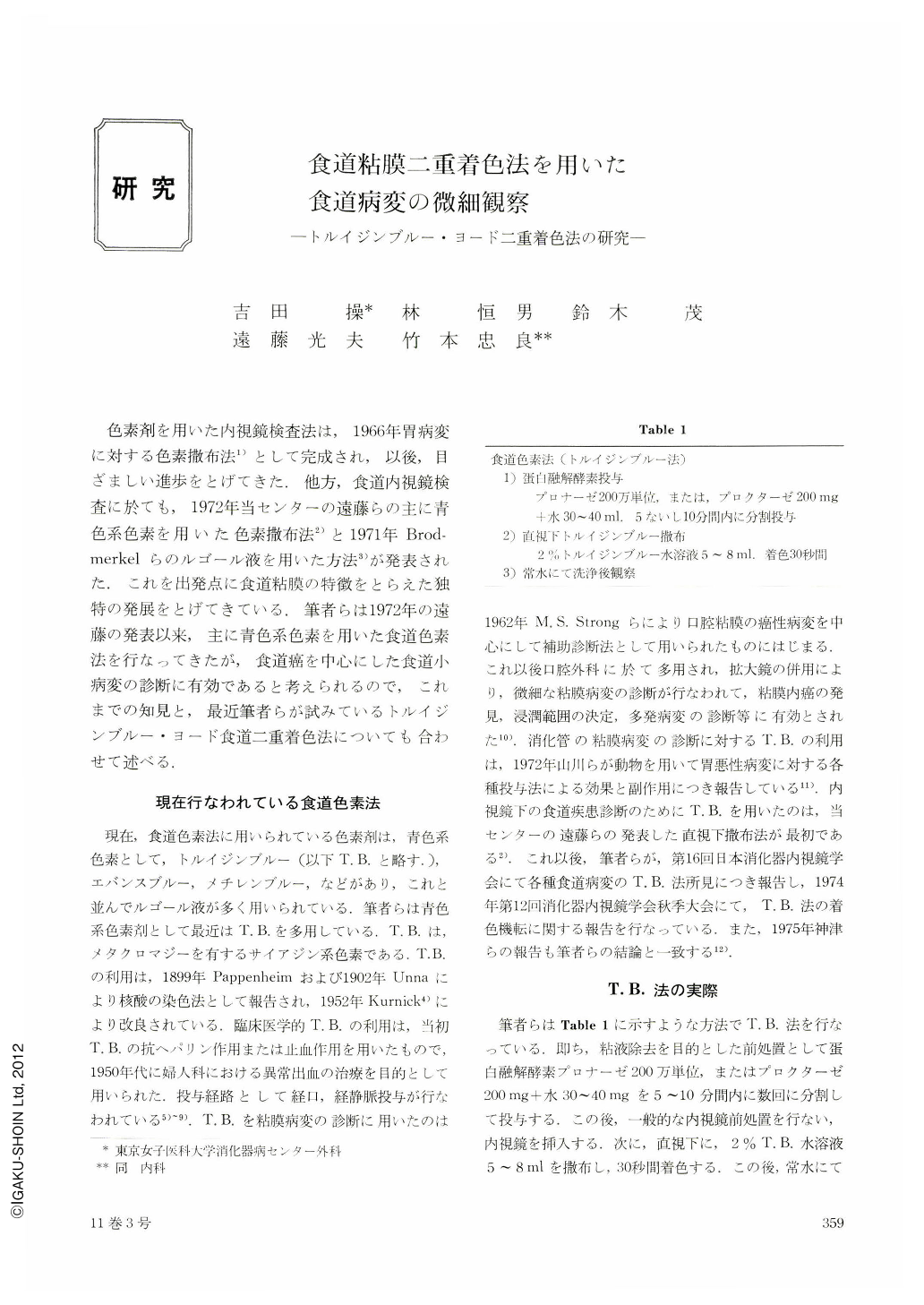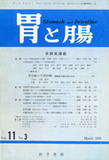Japanese
English
- 有料閲覧
- Abstract 文献概要
- 1ページ目 Look Inside
- サイト内被引用 Cited by
色素剤を用いた内視鏡検査法は,1966年胃病変に対する色素撒布法1)として完成され,以後,目ざましい進歩をとげてきた.他方,食道内視鏡検査に於ても,1972年当センターの遠藤らの主に青色系色素を用いた色素撒布法2)と1971年Brodmerkelらのルゴール液を用いた方法3)が発表された.これを出発点に食道粘膜の特徴をとらえた独特の発展をとげてきている.筆者らは1972年の遠藤の発表以来,主に青色系色素を用いた食道色素法を行なってきたが,食道癌を中心にした食道小病変の診断に有効であると考えられるので,これまでの知見と,最近筆者らが試みているトルイジンブルー・ヨード食道二重着色法についても合わせて述べる.
現在行なわれている食道色素法
現在,食道色素法に用いられている色素剤は,青色系色素として,トルイジンブルー(以下T.B.と略す.),エバンスブルー,メチレンブルー,などがあり,これと並んでルゴール液が多く用いられている.筆者らは青色系色素剤として最近はT.B.を多用している.T.B.は,メタクロマジーを有するサイアジン系色素である.T.B.の利用は,1899年Pappenheimおよび1902年Unnaにより核酸の染色法として報告され,1952年Kurnick4)により改良されている.臨床医学的T.B.の利用は,当初T.B.の抗ヘパリン作用または止血作用を用いたもので,1950年代に婦人科における異常出血の治療を目的として用いられた.投与経路として経口,経静脈投与が行なわれている5)~9).T.B.を粘膜病変の診断に用いたのは1962年M.S. Strongらにより口腔粘膜の癌性病変を中心にして補助診断法として用いられたものにはじまる.これ以後口腔外科に於て多用され,拡大鏡の併用により,微細な粘膜病変の診断が行なわれて,粘膜内癌の発見,浸潤範囲の決定,多発病変の診断等に有効とされた10).消化管の粘膜病変の診断に対するT.B.の利用は,1972年山川らが動物を用いて胃悪性病変に対する各種投与法による効果と副作用につき報告している11).内視鏡下の食道疾患診断のためにT.B.を用いたのは,当センターの遠藤らの発表した直視下撒布法が最初である2).これ以後,筆者らが,第16回日本消化器内視鏡学会にて各種食道病変のT.B.法所見につき報告し,1974年第12回消化器内視鏡学会秋季大会にて,T.B.法の着色機転に関する報告を行なっている.また,1975年神津らの報告も筆者らの結論と一致する12).
By our toluidine blue dying method, we can find small erosion, cancer or superficial infiltration of cancer as stained portion against the normal esophageal mucosa that remains unstained. Toluidine blue infiltrates into an esophageal lesion by 5~6 cell layers depth, and combines with living cells or degenerated tissue. Inflammatory lesions such as esophagitis have uniform distribution of pathologic changes moderately and evenly stained by toluidine blue. Cancer of the esopha gus has spots like small degenerated tissue, so that they are dyed moderately. However, under endoscopic magnification spot-like changes stained deep blue are scattered through the surface of the lesion.
On the other hand, by using iodine staining method, we con stain normal esophageal mucosa in brown, while abnormal mucosa such as inflammatory change, atrophy, erosion, ulcer, intraepithelial cancer infiltration and atypical cells is seen as poorly stained or unstained area.
For this reason, we have recently developed an endoscopic dyeing method to be called “ENDOSCOPIC TOLUIDINE BLUE-IODINE METHOD”. By this means we can utilize each property of two dyes simultaneously. There would be “NON-STAINED AREA” between the areas stained by the two independent dyes, which is observed as white bundle under endoscopic examination. In a cancer lesion, malignant tissue exposed to the surface is stained by toluidine blue, and so is superficial invasion. Since intraepithelial infiltration is not dyed either by toluidine blue or iodine, it forms a “NON-STAINED AREA” surrounded by iodine-stained normal mucosa. In erosive esophagitis, the surface of erosion is dyed by toluidine blue, while marginal or narrow area of the surrounding mucosa forms “NON-STAIND AREA” against the normal mucosa stained by iodine.
“NON-STAINED AREA” expresses an influence of pathologic changes on the normal esophageal mucosa.

Copyright © 1976, Igaku-Shoin Ltd. All rights reserved.


